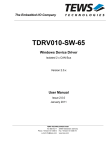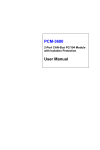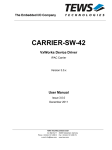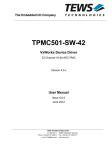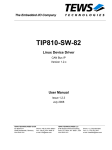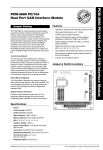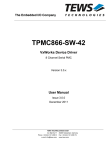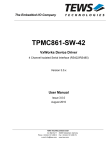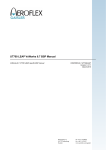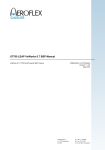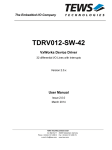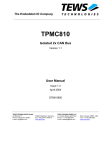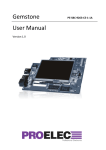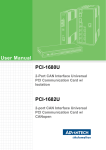Download User Manual - TEWS TECHNOLOGIES
Transcript
The Embedded I/O Company TDRV010-SW-42 VxWorks Device Driver Isolated 2x CAN Bus Version 3.0.x User Manual Issue 3.0.1 August 2015 TEWS TECHNOLOGIES GmbH Am Bahnhof 7 25469 Halstenbek, Germany Phone: +49 (0) 4101 4058 0 Fax: +49 (0) 4101 4058 19 e-mail: [email protected] www.tews.com TDRV010-SW-42 This document contains information, which is proprietary to TEWS TECHNOLOGIES GmbH. Any reproduction without written permission is forbidden. VxWorks Device Driver Isolated 2x CAN Bus TEWS TECHNOLOGIES GmbH has made any effort to ensure that this manual is accurate and complete. However TEWS TECHNOLOGIES GmbH reserves the right to change the product described in this document at any time without notice. Supported Modules: TPMC310 TPMC810 TEWS TECHNOLOGIES GmbH is not liable for any damage arising out of the application or use of the device described herein. 2005-2015 by TEWS TECHNOLOGIES GmbH Issue Description Date 1.0.0 First Issue October 12, 2005 1.0.1 Review November 8, 2005 1.1.0 Updated CAN Controller Speed Range and General Review May 30, 2006 1.1.1 Revision November 1, 2006 2.0.0 Support for VxBus and API description added November 16, 2009 2.0.1 Legacy vs. VxBus Driver modified March 26, 2010 2.0.2 tdrv010Init() function added September 22, 2010 3.0.0 API revised and documented, Basic I/O functions removed October 23, 2012 3.0.1 General Revision, Related Documents modified August 25, 2015 TDRV010-SW-42 – VxWorks Device Driver Page 2 of 57 Table of Contents 1 2 INTRODUCTION......................................................................................................... 4 INSTALLATION.......................................................................................................... 5 2.1 Legacy vs. VxBus Driver ................................................................................................................6 2.2 VxBus Driver Installation ...............................................................................................................7 2.2.1 Direct BSP Builds ...............................................................................................................8 2.3 Legacy Driver Installation ..............................................................................................................9 2.3.1 Include Device Driver in VxWorks Projects ........................................................................9 2.3.2 Special Installation for Intel x86 based Targets..................................................................9 2.3.3 System Resource Requirement........................................................................................10 3 API DOCUMENTATION ........................................................................................... 11 3.1 General Functions.........................................................................................................................11 3.1.1 tdrv010Open .....................................................................................................................11 3.1.2 tdrv010Close.....................................................................................................................13 3.1.3 tdrv010GetModuleInfo ......................................................................................................15 3.1.4 tdrv010GetControllerStatus ..............................................................................................18 3.2 Communication Functions...........................................................................................................21 3.2.1 tdrv010Read .....................................................................................................................21 3.2.2 tdrv010Write .....................................................................................................................25 3.3 Configuration Functions ..............................................................................................................29 3.3.1 tdrv010SetFilter ................................................................................................................29 3.3.2 tdrv010SetBitTiming .........................................................................................................32 3.3.3 tdrv010Start ......................................................................................................................34 3.3.4 tdrv010Stop ......................................................................................................................36 3.3.5 tdrv010FlushReceiveFifo ..................................................................................................38 3.3.6 tdrv010SelftestEnable.......................................................................................................40 3.3.7 tdrv010SelftestDisable......................................................................................................42 3.3.8 tdrv010ListenOnlyEnable .................................................................................................44 3.3.9 tdrv010ListenOnlyDisable.................................................................................................46 3.3.10 tdrv010Setlimit ..................................................................................................................48 3.3.11 tdrv010CanReset..............................................................................................................50 3.3.12 tdrv010CanSel ..................................................................................................................52 3.3.13 tdrv010CanInt ...................................................................................................................54 4 LEGACY I/O SYSTEM FUNCTIONS........................................................................ 56 4.1 tdrv010PciInit() ..............................................................................................................................56 5 DEBUGGING AND DIAGNOSTIC............................................................................ 57 TDRV010-SW-42 – VxWorks Device Driver Page 3 of 57 1 Introduction The TDRV010-SW-42 VxWorks device driver software allows the operation of the supported modules conforming to the VxWorks I/O system specification. The TDRV010-SW-42 release contains independent driver sources for the old legacy (pre-VxBus) and the new VxBus-enabled driver model. The VxBus-enabled driver is recommended for new developments with later VxWorks 6.x release and mandatory for VxWorks SMP systems. Both drivers, legacy and VxBus, share the same application programming interface (API) and deviceindependent basic I/O interface with open(), close() and ioctl() functions. The basic I/O interface is only for backward compatibility with existing applications and should not be used for new developments. Both drivers invoke a mutual exclusion and binary semaphore mechanism to prevent simultaneous requests by multiple tasks from interfering with each other. To prevent the application program for losing data, incoming messages will be stored in a message FIFO with a depth of 100 messages. The TDRV010-SW-42 device driver supports the following features: Transmit and receive Standard and Extended Identifiers Standard bit rates from 50 kbit up to 1.0 Mbit and user defined bit rates Message acceptance filtering Single-Shot transmission Listen only mode Message self reception Programmable error warning limit The TDRV010-SW-42 supports the modules listed below: TPMC310 Isolated 2x CAN (PMC, Conduction Cooled, Silent Mode Options) TPMC810 Isolated 2x CAN (PMC) To get more information about the features and use of the supported devices it is recommended to read the manuals listed below. TPMC310 and TPMC810 User Manual SJA1000 CAN Controller Manual TDRV010-SW-42 – VxWorks Device Driver Page 4 of 57 2 Installation Following files are located on the distribution media: Directory path ‘TDRV010-SW-42’: TDRV010-SW-42-3.0.1.pdf TDRV010-SW-42-VXBUS.zip TDRV010-SW-42-LEGACY.zip ChangeLog.txt Release.txt PDF copy of this manual Zip compressed archive with VxBus driver sources Zip compressed archive with legacy driver sources Release history Release information The archive TDRV010-SW-42-VXBUS.zip contains the following files and directories: Directory path ‘./tews/tdrv010’: tdrv010drv.c tdrv010def.h tdrv010.h tdrv010api.c tdrv010api.h sja1000.h Makefile 40tdrv010.cdf tdrv010.dc tdrv010.dr include/tvxbHal.h apps/tdrv010exa.c TDRV010 device driver source TDRV010 driver include file TDRV010 include file for driver and application TDRV010 API file TDRV010 API include file CAN controller driver include file Driver Makefile Component description file for VxWorks development tools Configuration stub file for direct BSP builds Configuration stub file for direct BSP builds Hardware dependent interface functions and definitions Example application The archive TDRV010-SW-42-LEGACY.zip contains the following files and directories: Directory path ‘./tdrv010’: tdrv010drv.c tdrv010def.h tdrv010.h tdrv010pci.c tdrv010api.c tdrv010api.h tdrv010exa.c include/tdhal.h sja1000.h TDRV010-SW-42 – VxWorks Device Driver TDRV010 device driver source TDRV010 driver include file TDRV010 include file for driver and application TDRV010 device driver source for x86 based systems TDRV010 API file TDRV010 API include file Example application Hardware dependent interface functions and definitions CAN controller driver include file Page 5 of 57 2.1 Legacy vs. VxBus Driver In later VxWorks 6.x releases, the old VxWorks 5.x legacy device driver model was replaced by VxBus-enabled device drivers. Legacy device drivers are tightly coupled with the BSP and the board hardware. The VxBus infrastructure hides all BSP and hardware differences under a well-defined interface, which improves the portability and reduces the configuration effort. A further advantage is the improved performance of API calls by using the method interface and bypassing the VxWorks basic I/O interface. VxBus-enabled device drivers are the preferred driver interface for new developments. The checklist below will help you to make a decision which driver model is suitable and possible for your application: Legacy Driver VxWorks 5.x releases VxWorks releases 6.5 and VxBus Driver VxWorks 6.6 and later releases with VxBus PCI bus SMP systems (only the VxBus driver is SMP safe!) 64-bit systems (only the VxBus driver is 64-bit compatible) earlier VxWorks 6.x releases without VxBus PCI bus support TEWS TECHNOLOGIES recommends not using the VxBus Driver before VxWorks release 6.6. rd In previous releases required header files are missing and the support for 3 -party drivers may not be available. TDRV010-SW-42 – VxWorks Device Driver Page 6 of 57 2.2 VxBus Driver Installation rd Because Wind River doesn’t provide a standard installation method for 3 party VxBus device drivers the installation procedure needs to be done manually. In order to perform a manual installation extract all files from the archive TDRV010-SW-42-VXBUS.zip rd to the typical 3 party directory installDir/vxworks-6.x/target/3rdparty (whereas installDir must be substituted by the VxWorks installation directory). After successful installation the TDRV010 device driver is located in the vendor and driver-specific directory installDir/vxworks-6.x/target/3rdparty/tews/tdrv010. At this point the TDRV010 driver is not configurable and cannot be included with the kernel configuration tool in a Wind River Workbench project. To make the driver configurable the driver library for the desired processer (CPU) and build tool (TOOL) must be built in the following way: (1) Open a VxWorks development shell (e.g. C:\WindRiver\wrenv.exe -p vxworks-6.7) (2) Change into the driver installation directory installDir/vxworks-6.x/target/3rdparty/tews/tdrv010 (3) Invoke the build command for the required processor and build tool make CPU=cpuName TOOL=tool For Windows hosts this may look like this: C:> cd \WindRiver\vxworks-6.7\target\3rdparty\tews\tdrv010 C:> make CPU=PENTIUM4 TOOL=diab To compile SMP-enabled libraries, the argument VXBUILD=SMP must be added to the command line C:> make CPU=PENTIUM4 TOOL=diab VXBUILD=SMP To build 64-bit libraries, the argument VXBUILD=LP64 must be added to the command line > make CPU=CORE TOOL=gnu VXBUILD=LP64 For 64-bit SMP-enabled libraries a build command may look like this > make CPU=CORE TOOL=gnu VXBUILD="LP64 SMP" To integrate the TDRV010 driver with the VxWorks development tools (Workbench), the component configuration file 40tdrv010.cdf must be copied to the directory installDir/vxworks6.x/target/config/comps/VxWorks. C:> cd \WindRiver\vxworks-6.7\target\3rdparty\tews\tdrv010 C:> copy 40tdrv010.cdf \Windriver\vxworks-6.7\target\config\comps\vxWorks In VxWorks 6.7 and newer releases the kernel configuration tool scans the CDF file automatically and updates the CxrCat.txt cache file to provide component parameter information for the kernel configuration tool as long as the timestamp of the copied CDF file is newer than the one of the CxrCat.txt. If your copy command preserves the timestamp, force to update the timestamp by a utility, such as touch. TDRV010-SW-42 – VxWorks Device Driver Page 7 of 57 In earlier VxWorks releases the CxrCat.txt file may not be updated automatically. In this case, remove or rename the original CxrCat.txt file and invoke the make command to force recreation of this file. C:> cd \Windriver\vxworks-6.7\target\config\comps\vxWorks C:> del CxrCat.txt C:> make After successful completion of all steps above and restart of the Wind River Workbench, the TDRV010 driver can be included in VxWorks projects by selecting the “TEWS TDRV010 Driver“ component in the “hardware (default) - Device Drivers” folder with the kernel configuration tool. 2.2.1 Direct BSP Builds In development scenarios with the direct BSP build method without using the Workbench or the vxprj command-line utility, the TDRV010 configuration stub files must be copied to the directory installDir/vxworks-6.x/target/config/comps/src/hwif. Afterwards the vxbUsrCmdLine.c file must be updated by invoking the appropriate make command. C:> cd \WindRiver\vxworks-6.7\target\3rdparty\tews\tdrv010 C:> copy tdrv010.dc \Windriver\vxworks-6.7\target\config\comps\src\hwif C:> copy tdrv010.dr \Windriver\vxworks-6.7\target\config\comps\src\hwif C:> cd \Windriver\vxworks-6.7\target\config\comps\src\hwif C:> make vxbUsrCmdLine.c TDRV010-SW-42 – VxWorks Device Driver Page 8 of 57 2.3 Legacy Driver Installation 2.3.1 Include Device Driver in VxWorks Projects For including the TDRV010-SW-42 device driver into a VxWorks project (e.g. Tornado IDE or Workbench) follow the steps below: (1) Extract all files from the archive TDRV010-SW-42-LEGACY.zip to your project directory. (2) Add the device drivers C-files to your project. Make a right click to your project in the ‘Workspace’ window and use the ‘Add Files ...’ topic. A file select box appears, and the driver files in the tdrv010 directory can be selected. (3) Now the driver is included in the project and will be built with the project. For a more detailed description of the project facility please refer to your VxWorks User’s Guide (e.g. Tornado, Workbench, etc.) 2.3.2 Special Installation for Intel x86 based Targets The TDRV010 device driver is fully adapted for Intel x86 based targets. This is done by conditional compilation directives inside the source code and controlled by the VxWorks global defined macro CPU_FAMILY. If the content of this macro is equal to I80X86 special Intel x86 conforming code and function calls will be included. The second problem for Intel x86 based platforms can’t be solved by conditional compilation directives. Due to the fact that some Intel x86 BSP’s doesn’t map PCI memory spaces of devices which are not used by the BSP, the required device memory spaces can’t be accessed. To solve this problem a MMU mapping entry has to be added for the required TDRV010 PCI memory spaces prior the MMU initialization (usrMmuInit()) is done. The C source file tdrv010pci.c contains the function tdrv010PciInit(). This routine finds out all TDRV010 devices and adds MMU mapping entries for all used PCI memory spaces. Please insert a call to this function after the PCI initialization is done and prior to MMU initialization (usrMmuInit()). The right place to call the function tdrv010PciInit() is at the end of the function sysHwInit() in sysLib.c (it can be opened from the project Files window). tdrv010PciInit(); Be sure that the function is called prior to MMU initialization otherwise the TDRV010 PCI spaces remains unmapped and an access fault occurs during driver initialization. Modifying the sysLib.c file will change the sysLib.c in the BSP path. Remember this for future projects and recompilations. TDRV010-SW-42 – VxWorks Device Driver Page 9 of 57 2.3.3 System Resource Requirement The table gives an overview over the system resources that will be needed by the driver. Resource Driver requirement Devices requirement Memory < 1 KB < 1 KB Stack < 1 KB --- Semaphores 2 4 Memory and Stack usage may differ from system to system, depending on the used compiler and its setup. The following formula shows the way to calculate the common requirements of the driver and devices. <total requirement> = <driver requirement> + (<number of devices> * <device requirement>) The maximum usage of some resources is limited by adjustable parameters. If the application and driver exceed these limits, increase the according values in your project. TDRV010-SW-42 – VxWorks Device Driver Page 10 of 57 3 API Documentation 3.1 General Functions 3.1.1 tdrv010Open Name tdrv010Open – opens a device. Synopsis TDRV010_HANDLE tdrv010Open ( char *DeviceName ) Description Before I/O can be performed to a device, a device descriptor must be opened by a call to this function. Parameters DeviceName This parameter points to a null-terminated string that specifies the name of the device. The first CAN channel on the first TDRV010 device is named “/tdrv010/0/0”, the second channel is named “/tdrv010/0/1”. The first CAN channel on the second TDRV010 device is named “/tdrv010/1/0” and so on. TDRV010-SW-42 – VxWorks Device Driver Page 11 of 57 Example #include “tdrv010api.h” TDRV010_HANDLE hdl; /* ** open the specified device */ hdl = tdrv010Open(“/tdrv010/0/0”); if (hdl == NULL) { /* handle open error */ } RETURNS A device handle, or NULL if the function fails. An error code will be stored in errno. ERROR CODES The error codes are stored in errno. The error code is a standard error code set by the I/O system. TDRV010-SW-42 – VxWorks Device Driver Page 12 of 57 3.1.2 tdrv010Close Name tdrv010Close – closes a device. Synopsis TDRV010_STATUS tdrv010Close ( TDRV010_HANDLE hdl ) Description This function closes previously opened devices. Parameters hdl This value specifies the device handle to the hardware module retrieved by a call to the corresponding open-function. Example #include “tdrv010api.h” TDRV010_HANDLE TDRV010_STATUS hdl; result; /* ** close the device */ result = tdrv010Close(hdl); if (result != TDRV010_OK) { /* handle close error */ } TDRV010-SW-42 – VxWorks Device Driver Page 13 of 57 RETURNS On success, TDRV010_OK is returned. In the case of an error, the appropriate error code is returned by the function. ERROR CODES Error Code Description TDRV010_ERR_INVALID_HANDLE The specified device handle is invalid TDRV010-SW-42 – VxWorks Device Driver Page 14 of 57 3.1.3 tdrv010GetModuleInfo Name tdrv010GetModuleInfo – get information of the module Synopsis TDRV010_STATUS tdrv010GetModuleInfo ( TDRV010_HANDLE hdl, unsigned int *pModuleType, unsigned int *pChannelNo, TDRV010_PCIINFO_BUF *pPciInfoBuf ) Description This function returns information about the module, including module type, local channel number and PCI header as well as the PCI localization. Parameters hdl This argument specifies the device handle to the hardware module retrieved by a call to the corresponding open-function. pModuleType This argument is a pointer to an unsigned int (32bit) data buffer, where the module type is returned. Possible values are: Value Description TDRV010_MODTYPE_TPMC310 Current module is a TPMC310 TDRV010_MODTYPE_TPMC810 Current module is a TPMC810 pChannelNo This argument is a pointer to an unsigned int (32bit) data buffer, where the local channel number of the device is returned. Possible values are 0 or 1. TDRV010-SW-42 – VxWorks Device Driver Page 15 of 57 pPciInfoBuf This argument is a pointer to the structure TDRV010_PCIINFO_BUF that receives information of the module PCI header. typedef struct { unsigned short vendorId; unsigned short deviceId; unsigned short subSystemId; unsigned short subSystemVendorId; int pciBusNo; int pciDevNo; int pciFuncNo; } TDRV010_PCIINFO_BUF; vendorId PCI module vendor ID. deviceId PCI module device ID subSystemId PCI module sub system ID subSystemVendorId PCI module sub system vendor ID pciBusNo Number of the PCI bus, where the module resides. pciDevNo PCI device number pciFuncNo PCI function number TDRV010-SW-42 – VxWorks Device Driver Page 16 of 57 Example #include “tdrv010api.h” TDRV010_HANDLE TDRV010_STATUS TDRV010_PCIINFO_BUF hdl; result; pciInfoBuf /* ** get module PCI information */ result = tdrv010GetPciInfo( hdl, &pciInfoBuf ); if (result != TDRV010_OK) { /* handle error */ } RETURN VALUE On success, TDRV010_OK is returned. In the case of an error, the appropriate error code is returned by the function. ERROR CODES Error Code Description TDRV010_ERR_INVALID_HANDLE The specified device handle is invalid TDRV010_ERR_INVAL Specified pointer is invalid. TDRV010-SW-42 – VxWorks Device Driver Page 17 of 57 3.1.4 tdrv010GetControllerStatus NAME tdrv010GetControllerStatus – Get CAN controller status information SYNOPSIS TDRV010_STATUS tdrv010GetControllerStatus ( TDRV010_HANDLE hdl, TDRV010_STATUS_BUF *pCANStatus ) DESCRIPTION This function returns the actual contents of several CAN controller registers for diagnostic purposes. PARAMETERS hdl This value specifies the device handle to the hardware module retrieved by a call to the corresponding open-function. pCANStatus This parameter points to a TDRV010_STATUS_BUF buffer, which receives the CAN controller status: typedef struct { unsigned char ArbitrationLostCapture; unsigned char ErrorCodeCapture; unsigned char TxErrorCounter; unsigned char RxErrorCounter; unsigned char ErrorWarningLimit; unsigned char StatusRegister; unsigned char ModeRegister; unsigned char RxMessageCounterMax; unsigned char PLDControl; } TDRV010_STATUS_BUF; ArbitrationLostCapture Contents of the arbitration lost capture register. This register contains information about the bit position of losing arbitration. TDRV010-SW-42 – VxWorks Device Driver Page 18 of 57 ErrorCodeCapture Contents of the error code capture register. This register contains information about the type and location of errors on the bus. TxErrorCounter Contents of the TX error counter register. This register contains the current value of the transmit error counter. RxErrorCounter Contents of the RX error counter register. This register contains the current value of the receive error counter. ErrorWarningLimit Contents of the error warning limit register. StatusRegister Contents of the status register. ModeRegister Contents of the mode register. RxMessageCounterMax Contains the peak value of messages in the software receive FIFO. This internal counter value will be reset to 0 after reading. PLDControl If available this parameter retrieves the content of the PLD Control Register. For non TPMC310 modules this parameter retrieves a value greater or equal 0x80 (means invalid). On TPMC310 devices the retrieved value will describe exactly the content of PLDControlReg[5:0]. TDRV010-SW-42 – VxWorks Device Driver Page 19 of 57 EXAMPLE #include “tdrv010api.h” TDRV010_HANDLE TDRV010_STATUS TDRV010_STATUS_BUF hdl; result; CanStatus; result = tdrv010GetControllerStatus( hdl, &CanStatus ); if (result != TDRV010_OK) { /* handle error */ } RETURN VALUE On success, TDRV010_OK is returned. In the case of an error, the appropriate error code is returned by the function. ERROR CODES Error Code Description TDRV010_ERR_INVALID_HANDLE The specified device handle is invalid. SEE ALSO SJA1000 Product Specification Manual TDRV010-SW-42 – VxWorks Device Driver Page 20 of 57 3.2 Communication Functions 3.2.1 tdrv010Read NAME tdrv010Read – Read a CAN message SYNOPSIS TDRV010_STATUS tdrv010Read ( TDRV010_HANDLE int unsigned int unsigned char unsigned char int unsigned char ) hdl, Timeout, *pIdentifier, *pIOFlags, *pStatus, *pLength, *pData DESCRIPTION This function reads a CAN message from the device driver receive queue. If no data is available, the function blocks until data is received or the specified timeout has expired. PARAMETERS hdl This value specifies the device handle to the hardware module retrieved by a call to the corresponding open-function. Timeout This parameter specifies the maximum time (in milliseconds) the function will block and wait for data if no data is available. Specify -1 to wait indefinitely, or 0 to return immediately. pIdentifier This parameter is a pointer to an unsigned int (32bit) value where the CAN message identifier is stored. TDRV010-SW-42 – VxWorks Device Driver Page 21 of 57 pIOFlags This parameter is a pointer to an unsigned char (8bit) value where CAN message attributes as a set of bit flags are stored. The following attribute flags are possible: Value Description TDRV010_EXTENDED Set if the received message is an extended message frame. Reset for standard message frames. TDRV010_REMOTE_FRAME Set if the received message is a remote transmission request (RTR) frame. pStatus This parameter is a pointer to an unsigned char (8bit) value where status information about overrun conditions either in the CAN controller or intermediate software FIFO is stored. The following values are possible: Value Description TDRV010_SUCCESS No messages lost TDRV010_FIFO_OVERRUN One or more messages was overwritten in the receive queue FIFO. This problem occurs if the FIFO is too small for the application read interval. TDRV010_MSGOBJ_OVERRUN One or more messages were overwritten in the CAN controller message FIFO because the interrupt latency is too large. Reduce the CAN bit rate or upgrade the system speed. pLength This parameter is a pointer to an int value where the length of the received CAN message (number of bytes) is stored. Possible values are 0..8. pData This parameter is a pointer to an unsigned char array where the received CAN message is stored. This buffer receives up to 8 data bytes. pData[0] receives message Data 0, pData[1] receives message Data 1 and so on. TDRV010-SW-42 – VxWorks Device Driver Page 22 of 57 EXAMPLE #include “tdrv010api.h” TDRV010_HANDLE TDRV010_STATUS int unsigned int unsigned char unsigned char int unsigned char hdl; result; Timeout; Identifier; IOFlags; Status; Length; Data[8]; /* ** Read a CAN message from the device. ** If no data is available, wait 5000ms for incoming messages. */ Timeout = 5000; result = tdrv010Read( hdl, Timeout, &Identifier, &IOFlags, &Status, &Length, &Data[0] ); if (result != TDRV010_OK) { /* handle error */ } RETURN VALUE On success, TDRV010_OK is returned. In the case of an error, the appropriate error code is returned by the function. TDRV010-SW-42 – VxWorks Device Driver Page 23 of 57 ERROR CODES Error Code Description TDRV010_ERR_INVALID_HANDLE The specified device handle is invalid. TDRV010_ERR_TIMEOUT Read was blocked and the allowed time has elapsed. TDRV010_ERR_BUSOFF The controller is in bus OFF state and no message is available in the receive queue. Note, as long as CAN messages are available in the receive queue FIFO, bus OFF conditions were not reported by the read function. This means you can read all CAN messages out of the receive queue FIFO during bus OFF state without an error result. TDRV010-SW-42 – VxWorks Device Driver Page 24 of 57 3.2.2 tdrv010Write NAME tdrv010Write – Write a CAN message SYNOPSIS TDRV010_STATUS tdrv010Write ( TDRV010_HANDLE int unsigned int unsigned char int unsigned char ) hdl, Timeout, Identifier, IOFlags, Length, *pData DESCRIPTION This function writes a CAN message to the CAN bus. The function waits for the message to be sent until the specified timeout has expired. PARAMETERS hdl This value specifies the device handle to the hardware module retrieved by a call to the corresponding open-function. Timeout Specifies the amount of time (in milliseconds) the caller is willing to wait for execution of write request. A value of -1 means wait indefinitely. If Timeout is set to 0 the function will return immediately after initiating the write in the CAN controller. Identifier Contains the message identifier of the CAN message to write. TDRV010-SW-42 – VxWorks Device Driver Page 25 of 57 IOFlags Contains a set of bit flags, which define message attributes and controls the write operation. To set more than one bit flag the predefined macros must be binary OR’ed. Value Description TDRV010_EXTENDED Transmit an extended message frame. If this macro isn't set or the "dummy" macro TDRV010_STANDARD is set a standard frame will be transmitted. TDRV010_REMOTE_FRAME A remote transmission request (RTR bit is set) will be transmitted. TDRV010_SINGLE_SHOT No re-transmission will be performed if an error occurred or the arbitration will be lost during transmission (single-shot transmission). TDRV010_SELF_RECEPTION The message will be transmitted and simultaneously received if the acceptance filter is set to the corresponding identifier. Length Contains the number of message data bytes (0...8). pData This buffer contains up to 8 data bytes. pData[0] contains message Data 0, pData[1] contains message Data 1 and so on. TDRV010-SW-42 – VxWorks Device Driver Page 26 of 57 EXAMPLE #include “tdrv010api.h” TDRV010_HANDLE TDRV010_STATUS int unsigned int unsigned char int unsigned char hdl; result; Timeout; Identifier; IOFlags; Length; Data[8]; /* ** Write an extended CAN message to the device. */ Identifier = 1234; Timeout = 5000; IOFlags = TDRV010_EXTENDED | TDRV010_SINGLE_SHOT; MsgLen = 2; Data[0] = 0xaa; Data[1] = 0x55; result = tdrv010Write( hdl, Timeout, Identifier, IOFlags, Length, &Data[0] ); if (result != TDRV010_OK) { /* handle error */ } RETURN VALUE On success, TDRV010_OK is returned. In the case of an error, the appropriate error code is returned by the function. TDRV010-SW-42 – VxWorks Device Driver Page 27 of 57 ERROR CODES Error Code Description TDRV010_ERR_INVALID_HANDLE The specified device handle is invalid. TDRV010_ERR_TIMEOUT The allowed time to finish the write request is elapsed. TDRV010_ERR_BUSOFF The controller is in bus OFF state and unable to transmit messages. TDRV010_ERR_INVAL Illegal message length (valid range is 0...8). TDRV010_ERR_COMM Transmission failed in single shot mode. TDRV010-SW-42 – VxWorks Device Driver Page 28 of 57 3.3 Configuration Functions 3.3.1 tdrv010SetFilter NAME tdrv010SetFilter – Configure Acceptance Filter SYNOPSIS TDRV010_STATUS tdrv010SetFilter ( TDRV010_HANDLE int unsigned int unsigned int ) hdl, SingleFilter, AcceptanceCode, AcceptanceMask DESCRIPTION This function modifies the acceptance filter of the specified CAN controller device. The acceptance filter compares the received identifier with the acceptance filter and decides whether a message should be accepted or not. If a message passes the acceptance filter it is stored in the receive FIFO. The acceptance filter is defined by the acceptance code registers and the acceptance mask registers. The bit patterns of messages to be received are defined in the acceptance code register. The corresponding acceptance mask registers allow defining certain bit positions to be "don't care" (a 1 at a bit position means "don't care"). A detailed description of the acceptance filter and possible filter modes can be found in the SJA1000 Product Specification Manual. This function will be accepted only in reset mode (BUSOFF). Use function tdrv010Stop() first. TDRV010-SW-42 – VxWorks Device Driver Page 29 of 57 PARAMETERS hdl This value specifies the device handle to the hardware module retrieved by a call to the corresponding open-function. SingleFilter Set TRUE (1) for single filter mode. Set FALSE (0) for dual filter mode. AcceptanceCode The contents of this parameter will be written to acceptance code register of the controller. AcceptanceMask The contents of this parameter will be written to the acceptance mask register of the controller. EXAMPLE #include “tdrv010api.h” TDRV010_HANDLE TDRV010_STATUS int unsigned int unsigned int hdl; result; SingleFilter; AcceptanceCode; AcceptanceMask; /* Not relevant because all bits are "don't care" */ AcceptanceCode = 0x0; /* Mark all bit position don't care */ AcceptanceMask = 0xffffffff; /* Single Filter Mode */ SingleFilter = 1; result = tdrv010SetFilter( hdl, SingleFilter, AcceptanceCode, AcceptanceMask ); if (result != TDRV010_OK) { /* handle error */ } TDRV010-SW-42 – VxWorks Device Driver Page 30 of 57 RETURN VALUE On success, TDRV010_OK is returned. In the case of an error, the appropriate error code is returned by the function. ERROR CODES Error Code Description TDRV010_ERR_INVALID_HANDLE The specified device handle is invalid. TDRV010_ERR_ACCESS Permission denied. The controller is currently in BUS ON state. Please enter the BUS OFF state before changing the acceptance filter. SEE ALSO tdrv010exa.c for a programming example. SJA1000 Product Specification Manual – 6.4.15 ACCEPTANCE FILTER TDRV010-SW-42 – VxWorks Device Driver Page 31 of 57 3.3.2 tdrv010SetBitTiming NAME tdrv010SetBitTiming – Modify CAN Bus transfer speed SYNOPSIS TDRV010_STATUS tdrv010SetBitTiming ( TDRV010_HANDLE hdl, unsigned short TimingValue, int UseThreeSamples ) DESCRIPTION This function modifies the bit timing registers of the CAN controller to setup a new CAN bus transfer speed. Use one sample point for faster bit rates and three sample points for slower bit rates to make the CAN bus more immune against noise spikes. This function will be accepted only in reset mode (BUSOFF). Use function tdrv010Stop() first. PARAMETERS hdl This value specifies the device handle to the hardware module retrieved by a call to the corresponding open-function. TimingValue This parameter holds the new value for the bit timing register 0 (bit 0...7) and for the bit timing register 1 (bit 8...15). Possible transfer rates are between 50 Kbit per second and 1 Mbit per second. The include file 'tdrv010api.h' contains predefined transfer rate symbols (TDRV010_5KBIT ... TDRV010_1MBIT). For other transfer rates please follow the instructions of the SJA1000 Product Specification, which is also part of the TPMC310 or TPMC810 engineering documentation. UseThreeSamples If this parameter is TRUE (1) the CAN bus is sampled three times per bit time instead of one. TDRV010-SW-42 – VxWorks Device Driver Page 32 of 57 EXAMPLE #include “tdrv010api.h” TDRV010_HANDLE TDRV010_STATUS int unsigned short hdl; result; UseThreeSamples; TimingValue; TimingValue UseThreeSamples = TDRV010_100KBIT; = FALSE; result = tdrv010SetBitTiming( hdl, TimingValue, UseThreeSamples ); if (result != TDRV010_OK) { /* handle error */ } RETURN VALUE On success, TDRV010_OK is returned. In the case of an error, the appropriate error code is returned by the function. ERROR CODES Error Code Description TDRV010_ERR_INVALID_HANDLE The specified device handle is invalid. TDRV010_ERR_ACCESS Permission denied. The controller is currently in BUS ON state. Please enter the BUS OFF state before changing the bit timing. SEE ALSO tdrv010exa.c for a programming example. tdrv010api.h for predefined bus timing constants. SJA1000 Product Specification Manual – 6.5.1/2 BUS TIMING REGISTER. TDRV010-SW-42 – VxWorks Device Driver Page 33 of 57 3.3.3 tdrv010Start NAME tdrv010Start – Set CAN controller into BUSON state SYNOPSIS TDRV010_STATUS tdrv010Start ( TDRV010_HANDLE ) hdl DESCRIPTION This function sets the specified CAN controller into the BUSON state. After an abnormal rate of occurrences of errors on the CAN bus or after driver startup, the CAN controller enters the BUSOFF state. This control function resets the "reset mode" bit in the mode register. The CAN controller begins the bus OFF recovery sequence and resets transmit and receive error counters. If the CAN controller counts 128 packets of 11 consecutive recessive bits on the CAN bus, the Bus Off state is exited. Before the driver is able to communicate over the CAN bus after driver startup, this control function must be executed. PARAMETERS hdl This value specifies the device handle to the hardware module retrieved by a call to the corresponding open-function. EXAMPLE #include “tdrv010api.h” TDRV010_HANDLE TDRV010_STATUS hdl; result; result = tdrv010Start( hdl ); if (result != TDRV010_OK) { /* handle error */ } TDRV010-SW-42 – VxWorks Device Driver Page 34 of 57 RETURN VALUE On success, TDRV010_OK is returned. In the case of an error, the appropriate error code is returned by the function. ERROR CODES Error Code Description TDRV010_ERR_INVALID_HANDLE The specified device handle is invalid. TDRV010_ERR_BUSOFF Unable to enter the Bus ON mode. SEE ALSO tdrv010exa.c for a programming example. SJA1000 Product Specification Manual – 6.4.3 MODE REGISTER (MOD). TDRV010-SW-42 – VxWorks Device Driver Page 35 of 57 3.3.4 tdrv010Stop NAME tdrv010Stop – Set CAN controller into BUSOFF state SYNOPSIS TDRV010_STATUS tdrv010Stop ( TDRV010_HANDLE hdl ) DESCRIPTION This function sets the specified CAN controller into the bus OFF state. After execution of this control function the CAN controller is completely removed from the CAN bus and cannot communicate until the control function tdrv010Start() is executed. PARAMETERS hdl This value specifies the device handle to the hardware module retrieved by a call to the corresponding open-function. EXAMPLE #include “tdrv010api.h” TDRV010_HANDLE TDRV010_STATUS hdl; result; result = tdrv010Stop( hdl ); if (result != TDRV010_OK) { /* handle error */ } TDRV010-SW-42 – VxWorks Device Driver Page 36 of 57 RETURN VALUE On success, TDRV010_OK is returned. In the case of an error, the appropriate error code is returned by the function. ERROR CODES Error Code Description TDRV010_ERR_INVALID_HANDLE The specified device handle is invalid. TDRV010_ERR_IO Unable to enter the Bus OFF mode. SEE ALSO tdrv010exa.c for a programming example. SJA1000 Product Specification Manual – 6.4.3 MODE REGISTER (MOD). TDRV010-SW-42 – VxWorks Device Driver Page 37 of 57 3.3.5 tdrv010FlushReceiveFifo NAME tdrv010FlushReceiveFifo – Flush software receive FIFO SYNOPSIS TDRV010_STATUS tdrv010FlushReceiveFifo ( TDRV010_HANDLE hdl ) DESCRIPTION This function flushes the software FIFO buffer of received CAN messages. PARAMETERS hdl This value specifies the device handle to the hardware module retrieved by a call to the corresponding open-function. EXAMPLE #include “tdrv010api.h” TDRV010_HANDLE TDRV010_STATUS hdl; result; result = tdrv010FlushReceiveFifo( hdl ); if (result != TDRV010_OK) { /* handle error */ } RETURN VALUE On success, TDRV010_OK is returned. In the case of an error, the appropriate error code is returned by the function. TDRV010-SW-42 – VxWorks Device Driver Page 38 of 57 ERROR CODES Error Code Description TDRV010_ERR_INVALID_HANDLE The specified device handle is invalid. TDRV010-SW-42 – VxWorks Device Driver Page 39 of 57 3.3.6 tdrv010SelftestEnable NAME tdrv010SelftestEnable – Enable self test facility SYNOPSIS TDRV010_STATUS tdrv010SelftestEnable ( TDRV010_HANDLE hdl ) DESCRIPTION This function enables the self test facility of the SJA1000 CAN controller. In this mode a full node test is possible without any other active node on the bus using the self reception facility. The CAN controller will perform a successful transmission even if there is no acknowledge received. Also in self test mode the normal functionality is given, that means the CAN controller is able to receive messages from other nodes and can transmit message to other nodes if any connected. This function will be accepted only in reset mode (BUSOFF). Use function tdrv010Stop() first. PARAMETERS hdl This value specifies the device handle to the hardware module retrieved by a call to the corresponding open-function. TDRV010-SW-42 – VxWorks Device Driver Page 40 of 57 EXAMPLE #include “tdrv010api.h” TDRV010_HANDLE TDRV010_STATUS hdl; result; result = tdrv010SelftestEnable( hdl ); if (result != TDRV010_OK) { /* handle error */ } RETURN VALUE On success, TDRV010_OK is returned. In the case of an error, the appropriate error code is returned by the function. ERROR CODES Error Code Description TDRV010_ERR_INVALID_HANDLE The specified device handle is invalid. TDRV010_ERR_ACCESS Permission denied. The controller is currently in BUS ON state. Please enter the BUS OFF state first. SEE ALSO tdrv010exa.c for a programming example. SJA1000 Product Specification Manual – 6.4.3 MODE REGISTER (MOD) TDRV010-SW-42 – VxWorks Device Driver Page 41 of 57 3.3.7 tdrv010SelftestDisable NAME tdrv010SelftestDisable – Disable self test facility SYNOPSIS TDRV010_STATUS tdrv010SelftestDisable ( TDRV010_HANDLE hdl ) DESCRIPTION This function disables the self test facility of the SJA1000 CAN controller, which was enabled before with the function tdrv010SelftestEnable(). This function will be accepted only in reset mode (BUSOFF). Use function tdrv010Stop() first. PARAMETERS hdl This value specifies the device handle to the hardware module retrieved by a call to the corresponding open-function. EXAMPLE #include “tdrv010api.h” TDRV010_HANDLE TDRV010_STATUS hdl; result; result = tdrv010SelftestDisable( hdl ); if (result != TDRV010_OK) { /* handle error */ } TDRV010-SW-42 – VxWorks Device Driver Page 42 of 57 RETURN VALUE On success, TDRV010_OK is returned. In the case of an error, the appropriate error code is returned by the function. ERROR CODES Error Code Description TDRV010_ERR_INVALID_HANDLE The specified device handle is invalid. TDRV010_ERR_ACCESS Permission denied. The controller is currently in BUS ON state. Please enter the BUS OFF state first. SEE ALSO tdrv010exa.c for a programming example. SJA1000 Product Specification Manual – 6.4.3 MODE REGISTER (MOD) TDRV010-SW-42 – VxWorks Device Driver Page 43 of 57 3.3.8 tdrv010ListenOnlyEnable NAME tdrv010ListenOnlyEnable – Enable listen-only facility SYNOPSIS TDRV010_STATUS tdrv010ListenOnlyEnable ( TDRV010_HANDLE hdl ) DESCRIPTION This function enables the listen only facility of the SJA1000 CAN controller. In this mode the CAN controller would give no acknowledge to the CAN-bus, even if a message is received successfully. Message transmission is not possible. All other functions can be used like in normal mode. This mode can be used for software driver bit rate detection and 'hot-plugging'. This function will be accepted only in reset mode (BUSOFF). Use function tdrv010Stop() first. PARAMETERS hdl This value specifies the device handle to the hardware module retrieved by a call to the corresponding open-function. EXAMPLE #include “tdrv010api.h” TDRV010_HANDLE TDRV010_STATUS hdl; result; result = tdrv010ListenOnlyEnable( hdl ); if (result != TDRV010_OK) { /* handle error */ } TDRV010-SW-42 – VxWorks Device Driver Page 44 of 57 RETURN VALUE On success, TDRV010_OK is returned. In the case of an error, the appropriate error code is returned by the function. ERROR CODES Error Code Description TDRV010_ERR_INVALID_HANDLE The specified device handle is invalid. TDRV010_ERR_ACCESS Permission denied. The controller is currently in BUS ON state. Please enter the BUS OFF state first. SEE ALSO tdrv010exa.c for a programming example. SJA1000 Product Specification Manual – 6.4.3 MODE REGISTER (MOD) TDRV010-SW-42 – VxWorks Device Driver Page 45 of 57 3.3.9 tdrv010ListenOnlyDisable NAME tdrv010ListenOnlyDisable – Disable listen-only facility SYNOPSIS TDRV010_STATUS tdrv010ListenOnlyDisable ( TDRV010_HANDLE hdl ) DESCRIPTION This function disables the self test facility of the SJA1000 CAN controller, which was enabled before with the function FIO_TDRV010_ENABLE_SELFTEST. This function will be accepted only in reset mode (BUSOFF). Use function tdrv010Stop() first. PARAMETERS hdl This value specifies the device handle to the hardware module retrieved by a call to the corresponding open-function. EXAMPLE #include “tdrv010api.h” TDRV010_HANDLE TDRV010_STATUS hdl; result; result = tdrv010ListenOnlyDisable( hdl ); if (result != TDRV010_OK) { /* handle error */ } TDRV010-SW-42 – VxWorks Device Driver Page 46 of 57 RETURN VALUE On success, TDRV010_OK is returned. In the case of an error, the appropriate error code is returned by the function. ERROR CODES Error Code Description TDRV010_ERR_INVALID_HANDLE The specified device handle is invalid. TDRV010_ERR_ACCESS Permission denied. The controller is currently in BUS ON state. Please enter the BUS OFF state first. SEE ALSO tdrv010exa.c for a programming example. SJA1000 Product Specification Manual – 6.4.3 MODE REGISTER (MOD) TDRV010-SW-42 – VxWorks Device Driver Page 47 of 57 3.3.10 tdrv010Setlimit NAME tdrv010SetLimit – Disable listen-only facility SYNOPSIS TDRV010_STATUS tdrv010SetLimit ( TDRV010_HANDLE hdl, unsigned char ErrorLimit ) DESCRIPTION This function sets a new error warning limit in the corresponding CAN controller register. The default value (after hardware reset) is 96. This function will be accepted only in reset mode (BUSOFF). Use function tdrv010Stop() first. PARAMETERS hdl This value specifies the device handle to the hardware module retrieved by a call to the corresponding open-function. ErrorLimit This parameter specifies the new error warning limit. TDRV010-SW-42 – VxWorks Device Driver Page 48 of 57 EXAMPLE #include “tdrv010api.h” TDRV010_HANDLE TDRV010_STATUS hdl; result; /* ** Set Error Warning Limit to 20 */ result = tdrv010SetLimit( hdl, 20 ); if (result != TDRV010_OK) { /* handle error */ } RETURN VALUE On success, TDRV010_OK is returned. In the case of an error, the appropriate error code is returned by the function. ERROR CODES Error Code Description TDRV010_ERR_INVALID_HANDLE The specified device handle is invalid. TDRV010_ERR_ACCESS Permission denied. The controller is currently in BUS ON state. Please enter the BUS OFF state first. SEE ALSO tdrv010exa.c for a programming example. SJA1000 Product Specification Manual – 6.4.10 ERROR WARNING LIMIT REGISTER (EWLR) TDRV010-SW-42 – VxWorks Device Driver Page 49 of 57 3.3.11 tdrv010CanReset NAME tdrv010CanReset – Set CAN controller into reset or operating mode SYNOPSIS TDRV010_STATUS tdrv010CanReset ( TDRV010_HANDLE hdl, unsigned char CanReset ) DESCRIPTION This function sets the certain CAN controller in reset or operating mode. After driver startup, the CAN controllers are configured to operating mode. This function is only available for TPMC310 devices. PARAMETERS hdl This value specifies the device handle to the hardware module retrieved by a call to the corresponding open-function. CanReset This parameter specifies the controller operating mode. Value Description TDRV010_CANRESET_RESET Set the certain CAN channel into reset mode TDRV010_CANRESET_OPERATING Set the certain CAN channel into operating mode TDRV010-SW-42 – VxWorks Device Driver Page 50 of 57 EXAMPLE #include “tdrv010api.h” TDRV010_HANDLE TDRV010_STATUS hdl; result; /* ** Set Controller into operating mode */ result = tdrv010CanReset( hdl, TDRV010_CANRESET_OPERATING ); if (result != TDRV010_OK) { /* handle error */ } RETURN VALUE On success, TDRV010_OK is returned. In the case of an error, the appropriate error code is returned by the function. ERROR CODES Error Code Description TDRV010_ERR_INVALID_HANDLE The specified device handle is invalid. TDRV010_ERR_NOTSUP Function not supported by the device. SEE ALSO TPMC310 User Manual TDRV010-SW-42 – VxWorks Device Driver Page 51 of 57 3.3.12 tdrv010CanSel NAME tdrv010CanSel – Set CAN transceiver into silent or operating mode SYNOPSIS TDRV010_STATUS tdrv010CanSel ( TDRV010_HANDLE unsigned char ) hdl, CanSel DESCRIPTION This function sets the certain CAN transceivers into silent or operating mode. After driver startup, the CAN transceivers are configured to operating mode. This function is only available for TPMC310 devices. PARAMETERS hdl This value specifies the device handle to the hardware module retrieved by a call to the corresponding open-function. CanSel This parameter specifies the controller operating mode. Value Description TDRV010_CANSEL_SILENT Set the certain CAN channel into silent mode TDRV010_CANSEL_OPERATING Set the certain CAN channel into operating mode TDRV010-SW-42 – VxWorks Device Driver Page 52 of 57 EXAMPLE #include “tdrv010api.h” TDRV010_HANDLE TDRV010_STATUS hdl; result; /* ** Set Transceiver into operating mode */ result = tdrv010CanSel( hdl, TDRV010_CANSEL_OPERATING ); if (result != TDRV010_OK) { /* handle error */ } RETURN VALUE On success, TDRV010_OK is returned. In the case of an error, the appropriate error code is returned by the function. ERROR CODES Error Code Description TDRV010_ERR_INVALID_HANDLE The specified device handle is invalid. TDRV010_ERR_NOTSUP Function not supported by the device. SEE ALSO TPMC310 User Manual TDRV010-SW-42 – VxWorks Device Driver Page 53 of 57 3.3.13 tdrv010CanInt NAME tdrv010CanInt – Enable or disable CAN controller interrupts SYNOPSIS TDRV010_STATUS tdrv010CanInt ( TDRV010_HANDLE unsigned char ) hdl, CanInt DESCRIPTION This function enables or disables certain CAN controller interrupts. After driver startup, the CAN controller interrupts are enabled. This function is only available for TPMC310 devices. PARAMETERS hdl This value specifies the device handle to the hardware module retrieved by a call to the corresponding open-function. CanInt This parameter specifies the controller operating mode. Value Description TDRV010_CANINT_ENABLE Enable interrupt of a certain CAN channel TDRV010_CANINT_DISABLE Disable interrupt of a certain CAN channel TDRV010-SW-42 – VxWorks Device Driver Page 54 of 57 EXAMPLE #include “tdrv010api.h” TDRV010_HANDLE TDRV010_STATUS hdl; result; /* ** Enable CAN controller interrupts */ result = tdrv010CanInt( hdl, TDRV010_CANINT_ENABLE ); if (result != TDRV010_OK) { /* handle error */ } RETURN VALUE On success, TDRV010_OK is returned. In the case of an error, the appropriate error code is returned by the function. ERROR CODES Error Code Description TDRV010_ERR_INVALID_HANDLE The specified device handle is invalid. TDRV010_ERR_NOTSUP Function not supported by device. SEE ALSO TPMC310 User Manual TDRV010-SW-42 – VxWorks Device Driver Page 55 of 57 4 Legacy I/O system functions This chapter describes functions which are relevant only for the legacy TDRV010 driver. 4.1 tdrv010PciInit() NAME tdrv010PciInit() – Generic PCI device initialization SYNOPSIS void tdrv010PciInit() DESCRIPTION This function is required only for Intel x86 VxWorks platforms. The purpose is to setup the MMU mapping for all required TPMC310 and TPMC810 PCI spaces (base address registers) and to enable the TDRV010 supported device for access. The global variable tdrv010Status obtains the result of the device initialization and can be polled later by the application before the driver will be installed. Value >0 0 <0 Meaning Initialization successful completed. The value of tdrv010Status is equal to the number of mapped PCI spaces No TDRV010 device found Initialization failed. The value of (tdrv010Status & 0xFF) is equal to the number of mapped spaces until the error occurs. Possible cause: Too few entries for dynamic mappings in sysPhysMemDesc[]. Remedy: Add dummy entries as necessary (syslib.c). EXAMPLE extern void tdrv010PciInit(); … tdrv010PciInit(); TDRV010-SW-42 – VxWorks Device Driver Page 56 of 57 5 Debugging and Diagnostic The TDRV010 device driver provides a function and debug statements to display versatile information of the driver installation and status on the debugging console. If the VxBus driver is used, the TDRV010 show routine is included in the driver by default and can be called from the VxWorks shell. If this function is not needed or program space is rare the function can be removed from the code by un-defining the macro INCLUDE_TDRV010_SHOW in tdrv010drv.c The tdrv010Show function (only if VxBus is used) displays detailed information about probed modules, assignment of devices respective device names to probed TDRV010 modules and device statistics. If TDRV010 modules were probed but no devices were created it may helpful to enable debugging code inside the driver code by defining the macro TDRV010_DEBUG in tdrv010drv.c. In contrast to VxBus TDRV010 devices, legacy TDRV010 devices must be created “manually”. This will be done with the first call to the tdrv010Open API function. -> tdrv010Show Probed Modules: [0] TPMC810: Bus=4, Dev=1, DevId=0x032a, VenId=0x1498, Init=OK, vxDev=0x498218 Associated Devices: [0] TPMC810: /tdrv010/0/0 /tdrv010/0/1 Device Statistics: /tdrv010/0/0: open count = 0 interrupt count = 1 bus off count = 0 receive count = 0 transmit count = 1 object overrun = 0 fifo overrun = 0 timing value = 0x2f43 Acceptance Code = 0x0 Acceptance Mask = 0xffffffff SingleFilter = Yes /tdrv010/0/1: open count = 0 interrupt count = 1 bus off count = 0 receive count = 1 transmit count = 0 object overrun = 0 fifo overrun = 0 timing value = 0x2f43 Acceptance Code = 0x0 Acceptance Mask = 0xffffffff SingleFilter = Yes TDRV010-SW-42 – VxWorks Device Driver Page 57 of 57

























































